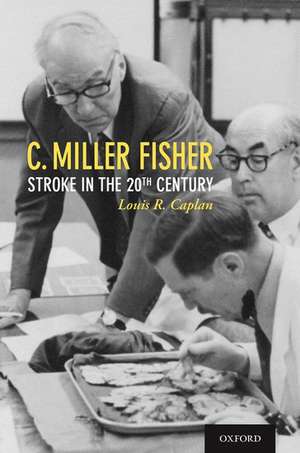C. Miller Fisher: Stroke in the 20th Century
Autor Louis R. Caplanen Limba Engleză Hardback – 25 aug 2020
Preț: 368.28 lei
Preț vechi: 453.42 lei
-19% Nou
Puncte Express: 552
Preț estimativ în valută:
70.47€ • 73.82$ • 58.40£
70.47€ • 73.82$ • 58.40£
Carte tipărită la comandă
Livrare economică 28 martie-03 aprilie
Preluare comenzi: 021 569.72.76
Specificații
ISBN-13: 9780190603656
ISBN-10: 0190603658
Pagini: 288
Dimensiuni: 155 x 239 x 25 mm
Greutate: 0.64 kg
Editura: Oxford University Press
Colecția OUP USA
Locul publicării:New York, United States
ISBN-10: 0190603658
Pagini: 288
Dimensiuni: 155 x 239 x 25 mm
Greutate: 0.64 kg
Editura: Oxford University Press
Colecția OUP USA
Locul publicării:New York, United States
Recenzii
This is a book to be studied upon ... as an investigation into one of the most important medical conditions of the 20th century.
This book is full of wit, interesting encounters, and a detailed history of prominent figures and discovery in medicine. The author does a good job at elucidating major life moments that built Fisher's character and set him on his path for his major discoveries that changed medicine forever. Fisher loved being a physician, he loved learning, and, most of all, he loved his patients. Reading C. Miller Fisher: Stroke in the 20th Century is a humble reminder of the beauty of medicine, the scientific method, and the incredible discoveries that Fisher gave the scientific community.
In this scholarly biography, Caplan has not only chronicled Miller Fisher's life, but has also described his extraordinary contributions to neurology, especially to cerebrovascular disease. The extensive references and images all serve to illustrate the history of stroke medicine in the second half of the twentieth century, making it an interesting and inspiring read.
Seldom has a medical story been told so well, so credibly, and so accurately by someone who has been a partner and participant in the advances that he describes. It is a delight to read by anyone with a health sciences background, and a must for those in the field of stroke.
Learning from the past is important, mostly from imminent clinicians in small circuits of excellence, as well as adapting from new morphological, biochemical, pharmacological, and functional technological methods and their interaction with many other disciplines close to and surrounding neurology. It is the merit of this wonderful book written by a pioneer of stroke neurology, Louis Caplan, whom both undersigning authors have much to thank in their own time of scientific interaction.
I will treasure this book. Stroke neurology under Fisher was something extraordinary, and Caplan reminds us how valuable it was. After closing this remarkable book, I realised that Fisher's transformative era, with its eagerness to see pathophysiology anew and its willingness to overturn assumptions while maintaining masterful attention to neurological detail, might perhaps now be distinctly and sadly no more-but hopefully not.
This book is full of wit, interesting encounters, and a detailed history of prominent figures and discovery in medicine. The author does a good job at elucidating major life moments that built Fisher's character and set him on his path for his major discoveries that changed medicine forever. Fisher loved being a physician, he loved learning, and, most of all, he loved his patients. Reading C. Miller Fisher: Stroke in the 20th Century is a humble reminder of the beauty of medicine, the scientific method, and the incredible discoveries that Fisher gave the scientific community.
In this scholarly biography, Caplan has not only chronicled Miller Fisher's life, but has also described his extraordinary contributions to neurology, especially to cerebrovascular disease. The extensive references and images all serve to illustrate the history of stroke medicine in the second half of the twentieth century, making it an interesting and inspiring read.
Seldom has a medical story been told so well, so credibly, and so accurately by someone who has been a partner and participant in the advances that he describes. It is a delight to read by anyone with a health sciences background, and a must for those in the field of stroke.
Learning from the past is important, mostly from imminent clinicians in small circuits of excellence, as well as adapting from new morphological, biochemical, pharmacological, and functional technological methods and their interaction with many other disciplines close to and surrounding neurology. It is the merit of this wonderful book written by a pioneer of stroke neurology, Louis Caplan, whom both undersigning authors have much to thank in their own time of scientific interaction.
I will treasure this book. Stroke neurology under Fisher was something extraordinary, and Caplan reminds us how valuable it was. After closing this remarkable book, I realised that Fisher's transformative era, with its eagerness to see pathophysiology anew and its willingness to overturn assumptions while maintaining masterful attention to neurological detail, might perhaps now be distinctly and sadly no more-but hopefully not.
Notă biografică
Louis R. Caplan, MD Professor of Neurology, Harvard University Neurologist, Beth Israel Deaconess Medical Centre
